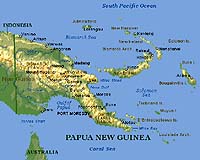| . |  |
. |
Porong, Indonesia (AFP) May 28, 2009 With no justice from her government, Indonesian villager Parti has her own plans for the company executives blamed for unleashing a mud volcano that buried her village three years ago. Throw them in the steaming, stinking sludge and let them burn, she says. "Let them burn to death so they can feel my suffering," said the 55-year-old mother of two, one of thousands of bitter victims who are still waiting for compensation so they can rebuild their shattered lives. "I'm not begging for sympathy, only demanding what's rightfully mine." Three years after the May 29, 2006 eruption of "Lusi," East Java's massive mud volcano continues to ooze foul sludge over the countryside, consuming homes and farmland and defying every attempt at containment. The mud -- a hot, bubbling, grey substance the consistency of wet concrete -- has already wiped out 12 villages, killed 13 people and displaced more than 42,000 people. Independent foreign experts have concluded that haphazard gas exploration drilling by local company Lapindo was almost certainly to blame for releasing the mud from deep below the earth's surface. No one has ever been prosecuted for the disaster but Lapindo was ordered to pay 3.8 trillion rupiah (386 million dollars) for mud containment efforts and compensation to over 10,000 families. The containment efforts have failed -- the mud has inundated another 200 hectares (500 acres) in the past year -- and many of the victims say they are still waiting for the money they need to replace their homes and incomes. "I lost a brick house, a petrol kiosk and a fruit stall and so far I've only received 30 million rupiah (2,900 dollars)," Parti told AFP from the bamboo shack she now calls home alongside hundreds of other displaced families. "But that's not all. I also lost comfort and privacy. My relatives have abandoned me because I'm poor now." Lapindo, which is connected to wealthy politician Aburizal Bakrie, has blamed the global financial crisis for its inability to pay the compensation in full. It says it has paid about half the money owed and has forged an agreement with the victims to pay the remainder in monthly installments until the end of next year. "We never expected the economic crisis to happen and have negotiated with victims," company spokeswoman Yuniwati Teryana told AFP. "They understood our situation and accepted settlement in monthly instalments. We hope to settle everything by December 2010." But villagers like Parti and 51-year-old Tiyami say the company is lying. "Stop the excuses and empty promises. There was no such crisis three years ago. Will I be a great-grandmother by the time I get the rest of my money back?" Tiyami said. Without new homes or any acceptable resettlement plan, about 2,000 villagers pooled what fractions of compensation they had received to buy 10 hectares of land and build a temporary village of flimsy bamboo shacks. "It rained for four days last week and the hut was flooded but it's better than staying in a campsite," Tiyami said. She now has a roof over her head, but she still can't find a job to replace her lost income. "I used to work in the paddy fields and sell eggs from my chickens and ducks. The mud destroyed them all," she said. Mud response officials said the devastated area now covered 800 hectares, up from about 600 a year ago. Another 6,000 people have been forced to flee their homes since October, they said. Lapindo initially tried to plug the gushing well with huge concrete balls, and has built massive containment walls to try to hold the mud, to no avail. Efforts now focus on directing the flow into a nearby river. Factory worker Mintase, 35, who lives 50 metres (yards) away from the containment wall, said mud is starting to spill over into his village after heavy rain. "We managed to direct the mud away but we may not be so lucky next time. Whenever it rains, I worry. I've placed my furniture with relatives and my house is almost empty now," she said. The world's largest mud volcano is proving a strong draw however for tourists, who are willing to pay to climb the embankments and observe the disaster as it unfolds, seemingly in slow motion. For 2,000 rupiah (20 cents), visitors are led up the wall to see the mud lake dotted with rooftops of sunken mosques and family homes. In the distance, at the centre, the original well hole spouts toxic white clouds several storeys into the air. "I lost my farming job after the mud wiped out the paddy fields. Now I can earn 10,000 rupiah a day from tourists. Enough to buy food," said 66-year-old mud victim Suparto. Share This Article With Planet Earth
Related Links Bringing Order To A World Of Disasters A world of storm and tempest When the Earth Quakes
 19 buried alive in PNG landslide: report
19 buried alive in PNG landslide: reportPort Moresby (AFP) May 26, 2009 Up to 19 people were buried alive when heavy rains triggered a landslide in remote Papua New Guinea, a report said Tuesday. Women and children were believed to be among those buried in the collapse, which hit Zongefifi village in Morobe province, on PNG's northwestern coast, in the early hours of Sunday morning, Australian Associated Press reported. A youth from a nearby village walked ... read more |
|
| The content herein, unless otherwise known to be public domain, are Copyright 1995-2009 - SpaceDaily. AFP and UPI Wire Stories are copyright Agence France-Presse and United Press International. ESA Portal Reports are copyright European Space Agency. All NASA sourced material is public domain. Additional copyrights may apply in whole or part to other bona fide parties. Advertising does not imply endorsement,agreement or approval of any opinions, statements or information provided by SpaceDaily on any Web page published or hosted by SpaceDaily. Privacy Statement |